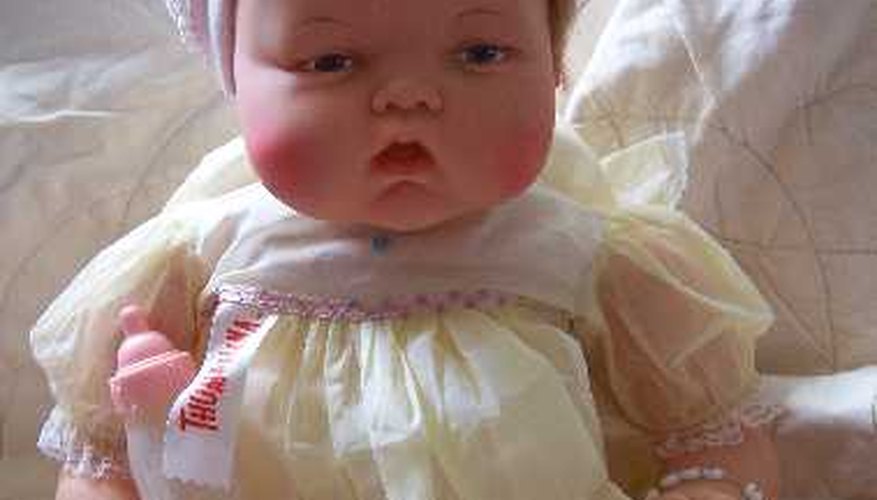The Thumbelina doll (in sizes 14, 16, 19 and 21 inches) by Ideal was one of the most popular baby dolls produced in the 1960s.
Attesting to their much-loved state, years later many Thumbelina dolls no longer have their characteristic "wiggle" or are in need of other repairs. There are certain steps that a collector can take to repair their Thumbelina and put her back in proper working condition.
First, slowly unwind the wire tie around the neck that attaches the doll's body and head. Winding this tie too many times will result in it breaking. Carefully remove staples at neck. Remove head and wooden doughnut/ring inside neck. The gear box is attached to a rod that goes through the wood ring at neck and into the doll's head.
- The Thumbelina doll (in sizes 14, 16, 19 and 21 inches) by Ideal was one of the most popular baby dolls produced in the 1960s.
- The gear box is attached to a rod that goes through the wood ring at neck and into the doll's head.
Cleaning the body: the cloth body should be spot-free and a nice medium shade of pink. "Spot" cleaning can result in stains on the cloth and is not advised. The cloth body may be fully cleaned in gentle detergent like cold-water Woolite or a no-chemical detergent for baby clothes after being disassembled. Next, remove inner stuffing. Wash body in warm or cool water with gentle detergent (baby detergent, Woolite) to avoid fading. The vinyl arms and feet can be scrubbed with a toothbrush or soft brush. Some spots may not come out except with additional stain treatment. Consult a doll repair professional for advice. Air dry fabric and vinyl.
- Cleaning the body: the cloth body should be spot-free and a nice medium shade of pink. "
- The cloth body may be fully cleaned in gentle detergent like cold-water Woolite or a no-chemical detergent for baby clothes after being disassembled.
Re-assemble doll by stuffing with clean cotton fill; leave enough space to reinsert rod and gear box back into body and insert top of rod back through wood ring and into head. Doll's body should be packed well but not overstuffed. After reassembling parts, try to staple doll's neck back in same place on wood ring, if possible, to make it easier. Re-twist wire tie. Carefully restitch seams using small stitches. Try to keep stitches hidden.
- Re-assemble doll by stuffing with clean cotton fill; leave enough space to reinsert rod and gear box back into body and insert top of rod back through wood ring and into head.
- After reassembling parts, try to staple doll's neck back in same place on wood ring, if possible, to make it easier.
Clean vinyl parts with soft cotton cloth and solvent made for cleaning vinyl dolls, available at doll suppliers. A non-ammonia window cleaner or Formula 409 also works well. Test in a small inconspicuous spot first. Consult a professional doll repairer or doll hospital to remove spots like marker or ink, especially on the face to avoid scraping or removing face paint.
If the doll no longer moves, replace the inner mechanism. Some replacement gear boxes are musical and may have a key instead of a knob. Ideal replacement knobs can be found on eBay, but the screw threads have to be of the same size. It can be trial and error finding a replacement knob. Remove doll's head and inner mechanism as described above. If doll is a crier (it will have small round holes in ear canals), the rod inserted into the head will have a small sound box on top. A new cry box can be found at a doll supplier or eBay. Attach to rod per instructions.
- If the doll no longer moves, replace the inner mechanism.
- Ideal replacement knobs can be found on eBay, but the screw threads have to be of the same size.
TIP
Wash doll's hair with baby shampoo and a touch of conditioner, or simply dampen hair, comb in conditioner, and let dry. Gently brush hair without pulling. Clean crevices such as mouth and ears with Q tips and window cleaner.
WARNING
Use cool to lukewarm water so as not to fade cloth body. It's best to ignore small spots and not clean body. Avoid scratching or scrubbing face colouring.
